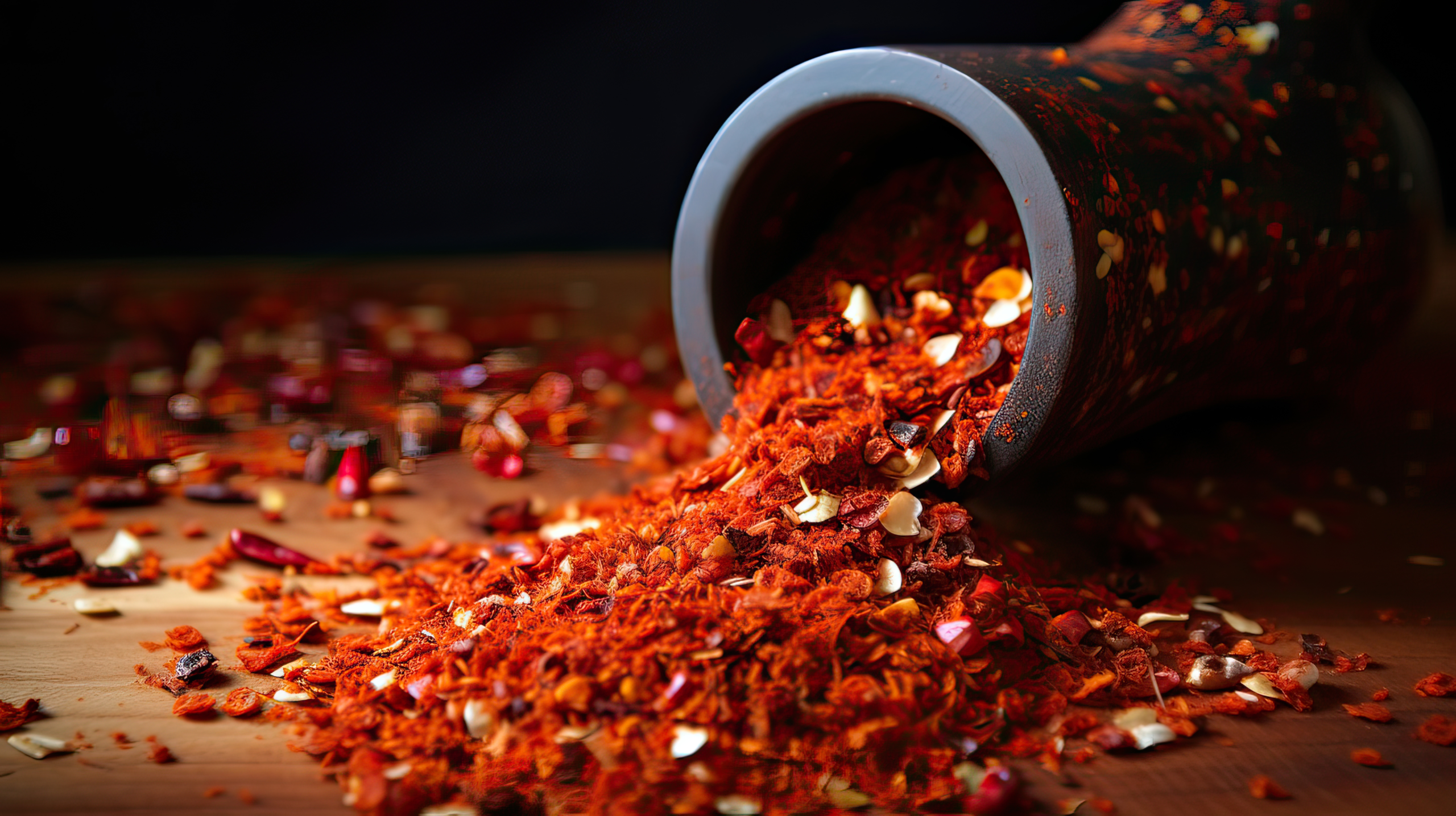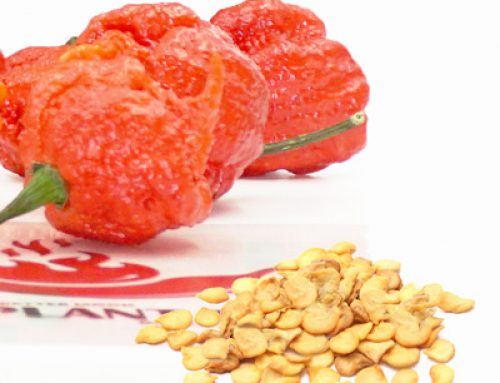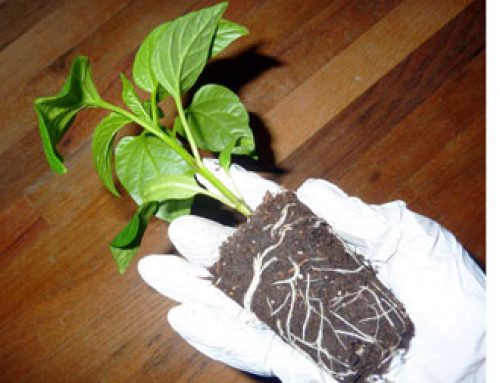From corner diners to gourmet kitchens, the world’s craving for spicier peppers is on the rise. This is nothing new; Ghost Peppers (Bhut Jolokia) set the bar high and outshone the milder peppers like Habaneros and Scotch Bonnets back in 2007. That’s when the Guinness World Records named the Bhut Jolokia the hottest chili pepper, ushering in the era of “superhots.” Now, Ghost Peppers are showing up in more places, even at places as accessible as Wendy’s.
Ghost Pepper originally comes from the states of Assam, Nagaland, Manipur, and Arunachal Pradesh in India. But as more people around the world have gotten interested in extremely spicy peppers, you can now find them in exotic spice shops and some farmers markets no matter where you are.
👉Also Read: How To Cook With Different Ghost Pepper Products
How Hot Is a Ghost Pepper?
The small Ghost Pepper chili, usually red, orange or chocolate-brown, is about the size of a thumb at 2.5 to 3.5 inches long and 1 inch wide. Unlike many other peppers, their skin is thinner, and the spicy component (capsaicin) is distributed evenly throughout the fruit, not just in the seeds and veins. This means the heat is consistent throughout the Ghost Pepper.
To give you an idea of their intense heat, peppers are measured in Scoville Heat Units (SHUs). For example, bell peppers score a zero, Tabasco sauce ranges from 2,500 to 5,000 SHUs, Jalapeños score between 3,500 and 10,000 SHUs, and Habaneros are around 100,000 to 350,000 SHUs. Before the 1980s, the hottest peppers were thought to max out at about 500,000 SHUs.
Then the Bhut Jolokia came along with a rating of over 1,000,000 SHUs and snatched the title of the world’s hottest pepper in 2007. It remained the champion until 2011 when it was overtaken by even hotter varieties like the Carolina Reaper, which can reach up to 2 million SHUs.
Still, before you decide to cook with a Ghost Pepper or Bhut Jolokia, keep in mind that it can be up to 417 times spicier than a Jalapeño. Indian Military actually uses it in non-lethal hand-grenades as a means to disperse crowds or to flush out terrorists from their hideouts. If that doesn’t tell you how potent just handling Ghost Peppers is, we don’t know what will.
Also, if you are making your own hot sauces or salsa with Ghost chili peppers, know that it might get even spicier as it sits. Over the subsequent weeks, as the ingredients blend together and the chili continues to develop, the heat in the Ghost Pepper hot sauce is likely to intensify.
But their white-hot spiciness is not the only thing why Ghost Peppers have a fanbase of their own. It’s the unique, smoky flavor that tastes delicious as well. The majority of hot peppers don’t have that; they only bring the heat and not much else.
How To Use Ghost Peppers in Recipes
At Magic Plant Farms, we have been growing, experimenting – and LOVING – Ghost Peppers for quite a while. That is not to brag, but to share with you some of our all-time favorite Ghost Pepper recipes. You can also check out our homemade hot sauce recipes here!
Spicy Wings
Ingredients:
- 2 lbs chicken wings
- 1/4 tsp Ghost Pepper powder (start with a pinch and adjust)
- 2 tbsp brown sugar
- 1 tsp garlic powder
- 1 tsp onion powder
- 1/4 cup soy sauce
- 1/4 cup olive oil
Instructions: In a bowl, mix together the brown sugar, garlic powder, onion powder, soy sauce, olive oil, and start with a pinch of Ghost Pepper powder (or as per your taste). Marinate the chicken wings in this mixture for at least 4 hours or overnight for best flavor absorption. Grill or bake the Ghost Pepper wings until fully cooked and crispy.
Optionally, before serving, brush with a little more marinade mixed with a small amount of Ghost Pepper powder. This step is crucial as it offers cost-effectiveness, extends shelf life, and allows you to customize the level of heat according to preference.
Spicy Curries
Ingredients:
- Your base ingredients (onion, garlic, ginger)
- Pinch of Ghost Pepper powder (adjust according to taste)
- Your choice of curry spices (turmeric, cumin, coriander, etc.)
- Your choice of main ingredients (chicken, vegetables, lentils)
Instructions: Prepare your base by sautéing onion, garlic, and ginger. Add a pinch of chili powder to your curry spices and mix into the sautéed base. Add your main ingredients and cook as per your curry recipe. Adjust the seasoning, including the pepper powder, as per your preference.
Spice Blends
For a basic hot spice blend, mix 1 part Ghost Pepper flakes (or powder) with 10 parts each of paprika, garlic powder, and onion powder for a versatile spice blend. Start with less Ghost Pepper and adjust to your taste.
Spicy Tomato Sauce
Ingredients:
- 16 oz. can of tomato sauce
- Pinch of Ghost Pepper powder/flakes (adjust according to taste)
Instructions: Mix the tomato sauce with a pinch of powder/flakes and simmer to blend the flavors. Taste and adjust the heat as needed. Use as a base for pasta, as a pizza sauce, or with meatballs.
Spicy Chocolate Bark
Ingredients:
- 8 oz chocolate of your choice
- Pinch of Ghost Pepper flakes
Instructions: Melt the chocolate and add the flakes. Pour onto a parchment-lined tray and add any desired toppings (nuts, dried fruit). Let it set before breaking into pieces. Adjust the Ghost Pepper to taste for the next batch if you desire more heat.
Spicy Sugar for Cocktails
Ingredients:
- 1 cup granulated sugar
- 1/8 tsp (or less) Ghost Pepper powder
Instructions: Mix the sugar with Ghost Pepper thoroughly and use it to rim glasses for your cocktails. (Don’t forget to warn your guests!).
Hot Veggie Chips
Ingredients:
- 2 lbs of thinly sliced vegetables (sweet potatoes, beets)
- 2 tbsp olive oil
- 1 tsp sea salt
- 1/4 tsp Ghost Pepper flakes (start with less and adjust)
Instructions: Preheat your oven to 375°F (190°C). Toss the sliced veggies with olive oil, salt, and flakes. Spread in a single layer on baking sheets. Bake until crispy, turning halfway through. Adjust the Ghost Pepper to taste.
4 Spice Blends From Around the World
Ethiopian Berbere with a Twist (For Stews, Lentil Dishes, and as a Rub for Grilled Meats)
Ingredients:
- 1/4 tsp Ghost Pepper powder
- 2 tbsp paprika (for a less smoky flavor than smoked paprika)
- 1 tsp salt
- 2 tsp ground ginger
- 2 tsp onion powder
- 1 tsp fenugreek seeds, ground
- 1 tsp ground coriander
- 1 tsp ground cardamom
- 1/2 tsp ground cinnamon
- 1/2 tsp ground cloves
Mexican Adobo Seasoning (For Marinades, Taco Fillings, and Grilled Vegetables)
Ingredients:
- 1/4 tsp Ghost Pepper powder
- 2 tbsp ancho chili powder
- 1 tbsp ground cumin
- 1 tbsp garlic powder
- 1 tbsp onion powder
- 1 tsp dried oregano
- 1 tsp ground cinnamon
- 1 tsp ground allspice
Thai Spice Mix (For Stir-Fries, Curries, and as a Seasoning for Grilled Fish)
Ingredients:
- 1/4 tsp Ghost Pepper powder
- 2 tbsp ground lemongrass
- 1 tbsp ground galangal (or substitute with ginger if unavailable)
- 1 tbsp garlic powder
- 1 tbsp ground coriander
- 1 tsp lime zest powder (or dried lime leaves, finely crushed)
- 1 tsp ground cumin
- 1 tsp shrimp paste powder (optional, adds umami)
Cajun Ghost Spice Mix (For Jambalaya, Gumbo, and Seasoning Seafood or Chicken)
Ingredients:
- 1/4 tsp Ghost Pepper powder
- 2 tbsp paprika (not smoked)
- 1 tbsp garlic powder
- 1 tbsp onion powder
- 1 tbsp dried thyme
- 1 tbsp dried oregano
- 1 tsp ground black pepper
- 1 tsp ground white pepper
- 1 tsp dried sage
- Salt to taste
NOTE: When using Ghost Pepper in any recipe, remember to start with the smallest amount. It’s easier to add more heat than to try and mitigate it after the fact.
👉Also Read: An In-Depth Look At The Ghost Pepper
Has your mouth started watering yet? Check out our ultimate collection of Bhut Jolokia dried whole pods, powders, flakes, mash, puree and more. Why take the risk of handling fresh Ghost Peppers and potentially injuring yourself when we have already done all the cleaning, deseeding, and preparing them for you!



